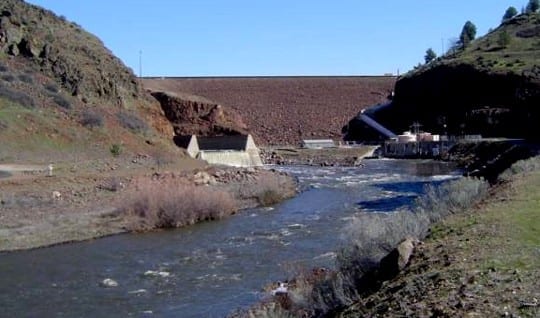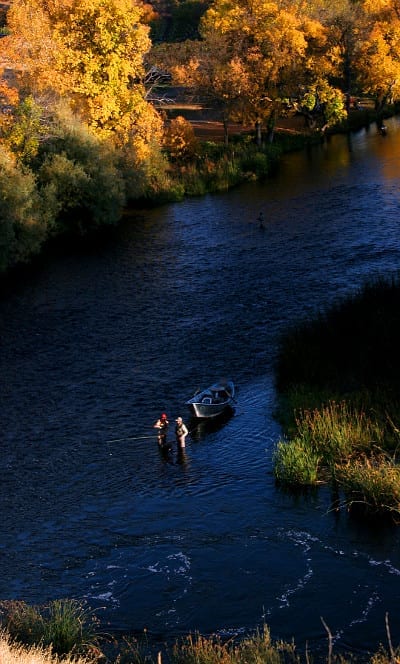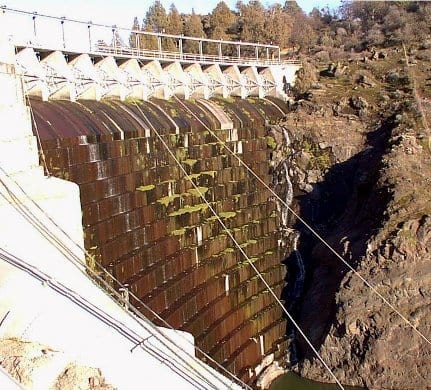A River At A Crossroads: The Case For Klamath Dam Removal
The Klamath River’s salmon and steelhead fisheries have been in steady decline for decades, and CalTrout strongly believes removing the four lower Klamath River dams remains the best option for restoring the Klamath’s once-storied salmon and steelhead stocks.

Iron Gate Dam on the Klamath River would be removed under the KBRA
The Klamath Basin Restoration Agreement (KBRA) — and its sister agreement, the Klamath Hydroelectric Settlement Agreement (KHSA) — were hammered out by diverse groups (including former “sworn” enemies like irrigators, commercial fishermen, native Americans, environmental groups, California, Oregon and others).
One of the goals is to restore the failing Klamath river while providing economic security for irrigators and other parties.
Critically, CalTrout believes these agreements will dramatically improve the Klamath’s steelhead fishery while restoring its fabled salmon and other endangered fish populations. This short position paper summarizes our reasons why.
Overview Of A River On The Brink
The Klamath River was historically among the top three most productive salmon rivers on the USA’s west coast; upwards of a million Chinook salmon returned every year to spawn. Between 1917 and 1965, a series of hydroelectric dams were constructed which severed access to almost 450 miles of Klamath River salmon and steelhead spawning habitat.
The dams degrade the river’s water quality (in the summer, toxic algae blooms turn the waters of the lakes pea-soup green, and health warnings are posted for miles down the river), and also heat the water, increasing stresses (an diseases) suffered by migrating fish.
Today, Pink and Chum salmon are extinct on the Klamath, and Coho salmon, Shortnose Suckers And Lost River suckers are listed under the Endangered Species Act.
Even the highly adaptable Chinook salmon returns represent a tiny fraction (10%) of their historic numbers, and many of those are hatchery fish, which produce inferior offspring with far lower survival rates.
Irrigators, Fishermen Both Lose
During the 2001 drought, water supplies to Upper Klamath Basin irrigators were cut off to protect endangered suckers, imposing an economic hardship on the area’s agricultural community.
In 2002, Vice President Dick Cheney intervened to reinstate water deliveries, resulting in untenably low flows — and the west coast’s largest ever fish kill (estimates suggest as many as 60,000 salmon died).
By 2006, salmon runs in both the Klamath and Sacramento watersheds had declined to the point that West Coast commercial salmon fisheries were closed to protect the decimated populations (this multi-year closure also decimated the commercial fishing communities along the coast).

Fishing on the Klamath is popular -- and would grow more so were salmon and steelhead populations to grow (photo Craig Nielsen)
Groups Look For A Solution
Without hint of progress in the air for fish or farmers, a group of over two dozen entities (including “sworn enemies” like irrigators, native American tribes, environmental groups and commercial fishermen) sat down and negotiated the Klamath Basin Restoration Agreement (KBRA).
It provides for reduced — but predictable — water supplies for Klamath Basin irrigators. The KBRA (and KHSA) also mandate the removal of the four lowest Klamath River Dams (Iron Gate, Copco 1 & 2, and J.C. Boyle), an increase in water storage capacity (wetlands restoration), and extensive habitat restoration projects.
Today, the Klamath Basin Restoration Agreement (KBRA) has been embraced by irrigators, Native Americans, PacifiCorp (owners) environmental groups, commercial fishermen, California, Oregon, and others.
The Case For The KBRA
Fisheries Improvements
With so many different species of fish in jeopardy on the formerly (and hugely) productive Klamath River, it’s clear fisheries need a boost.
Removing the four lower Klamath River dams would open up between 68 and 420 miles of spawning habitat to anadromous fish (the range varies based on the species), and the draft EIS/EIR suggests Chinook salmon populations (the most commonly fished for commercial salmon) would see an 81.4% boost in population should the KBRA be instituted.
Steelhead trout populations — perhaps California’s most desirable game fish — would also benefit from over 400 miles of enhanced spawning habitat, delivering a surge in recreation-based dollars to the area’s economy.
In fact, the draft EIS/EIR’s Benefits of The Proposed Action document suggests the steelhead and trophy Redband Rainbow trout fisheries would experience sizable benefits:
Distribution of Steelhead in the watershed is expected to expand to a greater degree than that of any other anadromous salmonid species under dam removal. Access to approximately 420 miles of historical habitat is estimated to again be available for steelhead upstream of the lowest dam.
Steelhead are the most prized game fish in the Klamath River; providing recreational fishing opportunities that would expand well into the Upper Basin in Oregon. Dam removal would also expand the total distribution of trophy Redband Rainbow trout in the fishery and would provide a more natural flow and temperature regime for trout and reintroduced salmon and steelhead.
In addition to dam removal, the KBRA also calls for habitat restoration projects and grows the acreage of the Upper Klamath wetlands, which offer the side benefit of more water storage than is currently provided by the four reservoirs (which would be removed).
Economic Benefits
Removing the privately owned lower Klamath Dams seems inevitable given the cost of keeping them:
-
Keeping the dams would require an estimated $450+ million in improvements (including fish passage); if removed, PacifiCorp’s liability is limited to $200 million
-
Operating the dams after relicensing would reduce power generation from an annual average of 82 MW to 62 MW, resulting in dams that would operate at a $20 million annual loss
It’s important to note that these four dams are privately owned by PacifiCorp, who makes decisions based on what’s best for the company and its ratepayers. In a presentation to the Siskiyou County Board of Supervisors, PacifiCorp’s CEO said:
Reiten stated that the issue of Klamath dam removal is not political for PacifiCorp, but one of business and economics.
Reiten said that retro-fitting the existing dams to comply with regulations and qualify for re-licensing would cost rate payers about $450 million. However, the company has negotiated a $200 million cap on rate payer contributions to the removal process, he said on Thursday.
“It comes down to an economic calculation, trying to cut the best deal for customers” Reiten said.
Finally, there are the sizable economic benefits (the draft EIS/EIR economic summary can be found here, though highlights include:
- 4600 new jobs as a result of dam removal over 15 year life of KBRA
- 1400 new jobs during the year of dam removal
- 70-695 additional jobs in the agricultural sector due to reliable water supplies.
- 453 new commercial fishery jobs
With the economics so starkly in favor of removal, it’s hardly surprising PacifiCorp is actively campaigning for the KBRA.
Reliable Water Supplies For Fish & Farmers
One of the drivers of the KBRA agreement were the constant lawsuits which plagued the Klamath River Basin over the last couple decades. After the 2001 irrigation water turn-off and the 2002 fish kill, formerly “sworn” enemies met and proceeded to hash out the KBRA.
While Upper Klamath irrigators gave up some of their water rights, they’ll receive regular, predictable water allocations, allowing them to plan for the future.
In the same vein, fisheries groups wanted more water for fish than they ultimately got, but felt that endangered salmon populations would recover, and that fast-disappearing salmon populations wouldn’t survive decades more neglect.

Copco Dam 1 on the Klamath River
Six Common Myths About Dam Removal
Opponents of dam removal have cited several reasons the dams shouldn’t be removed, though many of the often-cited reasons are more myth than reality. Here are a few.
Removing The Dams Will Harm Irrigators
This myth has been often heard in public discussions, but the four dams slated for removal provide no irrigation function. All irrigation withdrawals take place upstream, and since water doesn’t flow uphill, there simply isn’t any truth to this myth.
These Dams Provide Flood Control Protection
The draft EIS/EIR projects a maximum 7% difference in Klamath River flows if the dams are removed. The four lower Klamath River dams are not designed to control flows; they’re “run of river” dams which provide little water holding capacity.
In fact, they can store less than 10 hours of high springtime runoff flows before they reach capacity (and start spilling).
In other words, they can’t buffer high flows, so they offer little (if any) real flood protection from high flows.
The Dams Provide “Cheap, Clean” Energy
First, if reservoirs are creating toxic algae blooms, returning warmed water to the river, and starving the Lower Klamath of sediment, they aren’t “clean.” Some hydropower dams operate without significant impacts on fisheries and riverine habitats, but these dams aren’t among that group.
As for the cheap energy argument, FERC estimates the dams will operate at a $20 million annual loss if retained — costs that will have to be borne by PacifiCorp’s ratepayers. In addition, the costs of decimated salmon populations on commercial and recreation salmon/steelhead fishing industry are significant (453 new commercial fishing jobs will be created by the KBRA).
If relicensed, the four lower Klamath River dams would generate less than 2% of PacifiCorp’s energy, and with the utility committing to generating 1400 MW of energy from renewable resources, the loss of 62 MW remains a drop in the ocean.
A Redding Record-Searchlight editorial put it bluntly when they said:
Perfectly good dams? If they were, they’d have been relicensed long ago, as so many of PG&E’s dams are. These are dams with obvious problems.
—Redding Record-Searchlight
The Dams Protect Salmon Populations
Some say the Klamath used to “dry up” in normal years prior to the dams, so the dams are actually protecting the salmon.
It’s not true. The historic low flows on the river (prior to dam building) were in the 800 cfs neighborhood — far from dry. The KBRA provides for a minimum of 800 cfs flows where Iron Gate Dam is today; contrast that with summer flows in 1992 at the same location, which fell to 400 cfs.
The dams aren’t protecting salmon, they’re hammering water quality.
Sediment Is Toxic And Will Destroy Salmon Populations
Extensive testing has shown that very little toxic material is contained in the sediment piling up behind the four lower Klamath River dams, and as seen in dam removal projects like Marmot, Condit, Powderdale and the Clark Fork (MT), rivers have the ability move sediment downriver very quickly during high flows.
The draft EIS/EIR predicts that sediment clouds will have a negative affect on fish populations for a short time after dam removal, but the long-term benefits will be sizable.
Coho Salmon Are Not Native To The Klamath River
This astonishing claim has gained a foothold among dam removal opponents in Siskiyou County, though the evidence used to support it is largely non-existent. Some cite the lack of information about Coho salmon prior to an 1895 planting of Coho in the Trinity River (a large tributary of the Klamath), yet it’s clear that little distinction was made between species of salmon in that era. In addition:
- The Klamath River falls within in the native range of Coho salmon
- Several tributaries of the river (notably the Scott and Shasta Rivers) provide excellent Coho salmon habitat
Still, some cite the 1895 planting of Coho in the Trinity River (A large tributary to the Klamath) as the beginning of the Coho population on the Klamath, ignoring a few key facts:
- The Coho were only stocked in the Trinity in an attempt to supplement the native stocks, which had been decimated by a cannery operation at the mouth of the river
- A California Fish & Game document makes it clear that the 1895 stocking couldn’t have been the source of the Klamath’s Coho populations:
Regardless, because of their three-year life cycle, coho salmon returns from the 1895 plant would have appeared at the Klamathon Racks in only one or two of every three consecutive years. Egg take records from the Klamathon Racks show that this is not the case: coho salmon eggs were taken in substantial numbers in consecutive years beginning with the 1912-1913 season ( Appendix Table D-1).
This would not have been possible if all the adult fish had been descendants of fry and yearling plants made in 1895.
More Klamath River Dam Removal Resources
The Klamath Basin Restoration Agreement (KBRA) and its sister agreement, the Klamath Hydropower Settlement Agreement (KHSA) can be found here.
The draft Environmental Impact Statement (EIS) and Environmental Impact Report (EIR) are available here (along with selected elements of each should you not want to pick your way through the entire document).





2 Comments
Great Job! I hope we all live to see the Klamath recover.
We’d love to see that too. Some of CalTrout’s people have been working on this more than a decade…